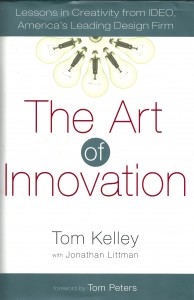The one-sentence summary
Successful innovation needs the right conditions and attitude – an eye for what can be improved, a rapid approach to prototyping, and a resilient problem-solving orientation.
WHAT THE BOOK SAYS 
- This is the 2001 classic from the founder of innovation agency Ideo.
- A number of principles are outlined, all of which contribute to the right conditions for high quality innovation:
- Innovation at the top: it’s no good someone tinkering in a basement – the mandate to innovate has to come from the top.
- Winging it in start-up mode: fast and practical problem solving is the right attitude.
- Innovation begins with an eye: great innovators notice things that annoy them or that can be made better – they keep a “bug list” of things that bug them and look for better alternatives.
- Perfect brainstorms: doing them well is an art and requires regular practice (see later). Bodystorming is acting out the customer experience.
- Hot groups: small, diverse teams work best. Look for visionaries, iconoclasts, troubleshooters, craftsmen, technologists, and cross-dressers (people who have had more than one type of career).
- Prototyping as shorthand: making them fast and early improves the process.
- Build a greenhouse: the office needs to be a place where these ideas can flourish.
- Expect the unexpected: nothing proceeds smoothly – innovators expect hitches and are good at overcoming barriers.
WHAT’S GOOD ABOUT IT
- Innovators understand customer needs by imagining themselves to be “left-handed”, or by seeing things through a child’s eyes.
- It helps to view products as verbs – then you can properly envisage them in action and design them more appropriately.
- Good brainstorms involve a sharp (non-fuzzy) focus; playful rules; numbering your ideas; building and jump from idea to idea; using the physical space (usually the walls) to capture everything; stretching your mental muscles; and getting physical.
- Abolish the word “they” in the office: “we” are responsible for everything.
- Cross-pollination can be achieved by surfing widely different information sources, taking on the perspective of a film director, holding an open house, talking to advocates, hiring outsiders, changing hats, and being trained in a new skill.
- Watch customers incessantly, play with your physical workspace, break rules, and “fail forward” so that change is part of the culture.
WHAT YOU HAVE TO WATCH
- Not much. This is a classic handbook for anyone wishing to innovate.
